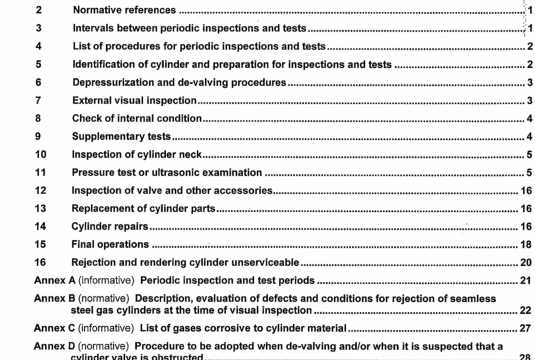ISO 6406 pdf download – Gas cylinders -Seamless steel gas cylinders – Periodic inspection and testing.
11.3 Hydrauhc volumetric expansion test
Annex E proposes typical methods for carrying out thIs test and gives details for determining the volumetric expansion of seamless steel gas cylinders by the preferred water cket method or the non-water jacket method. The test methods, equipment and procedure chosen shall be approved by the authorized body. The water jacket volumetric expansion test shall be carried out on equipment with a levelling burette, with a fixed burette, or with a weighing bowl. Care shall be taken that the entire external surface of the cylinder is wet without the presence of any bubbles.
The permanent voli.rnetiic expansion of the cyl Wider expressed as a percentage at the total expansion at test pressure shaJi not exceed the percentage given In the design specification after the cylinder has been held at test pressure for a minimum period of 30s. It this figure for permanent expansion Is exceeded, the cylinder shall be rendered unserviceable.
11.4 UltrasonIc examination
11.4.1 Background
The ultrasonic examination of gas cylinders as described below Is based on the ultrasonic examination of pipes in accordance with ISO 9305, ISO 9764 arid ISO 10543. The special geometrical features of gas cylinders and the boundary conditions for periodic inspections have been taken into account.
11.4.2 Scope
The ultrasonic examination (UE) of seamless steel gas cylinders (water capacity 21) withIn the framewiork of
periodic rspec*ions may be carned out m lieu of the tests described in 11.2 and 11.3.
11.4.3 Requlr.m.nts
11.4.3.1 General
The cylindxical part of the cylinder, the transItion to the shoulder, the transition at the base and critical zones of the base shall be examined ultrasonically with the help clan automated examination device (e.g. Figure 1). When such an examination device is not able to do this outside the cytindrical secin, a supplementary manual examination shaM be performed (a.. Figure 2).
Cylinders that are suspected of fire or heat damage shall not be examined ultrasonically.
11.4.3.2 ExamInation equipment
The Installation shall be able to scan the whole surface of the cylindrical pert of the cylinder, including the adjacent transitions to the base and shoulder. An inspection system shall have a number and type of transducers and different beam directions reqilred to identity all the reference features In the calibration piece. Such an installation may have five or mote ukrasonic transducers suitably arranged (e.g. FIgure 3).
Other arrangements of transducers may be possible provided that longitudinal and transverse defects can be detected.
Any ultrasonic method (e.g. the pulse echo, guided wave) that demonstrates the ability to detect defects and to measure waN thickness shall be used. The most common techniques used today are the contact or the Immersion type. Other techniques may be used. See Figure 4 as an example.
11.4.4.4 Fr.qu.ncy of calibration
The UE equipment Shall be calibrated at least at the beginning and at the end of each operator shift, regardless of length, and wtwn any timing equipment is changed (e.g. change of transducer). Calibration shall also be undertaken at the end of operations that are of a duration less than that of a normal shift It, during the cairation. the presence of the respective reference notch Is nof detected. all cylinders examined subsecpiently to the last acceptable calibration must be re..exsmlned after the equipment has been recalibrated.
11.4.5 PerformIng the examination
11.4.5.1 Defect detection in cylindrical section by automated Installation
The cyli&1cal section of the cyknder and the transitions to the shoulder and to the base shell be examined for longitudinal and transverse defects using an automatic examination device.
The pulse repetition rate of the transducers, rotational speed of the cylinder, and axial speed of the scanning head shall be mutually adjusted in such a way that the system Is capable of locating all of the calibration flaws. At no time shall the speeds used during calibration be exceeded during the examination. Ensure that the system provides 100% coverage of the surface being examined. When epplicable, e.g. a helix-based system, at least 10% overtap shall be guaranteed. Figure 7 shows notch placement for examination of an SBT.
11.4.5.2 Defect detction In cyilnd.r .nds for cyllnd.rs wIth foot-rings
In the case of cylinders with foot-rings, the critical area in the transition zone shall be checked taking into
account the accessibility of the test surface and the roughness of the external surface (see Figure 2).
11.4.5.3 Wall thickness measurement by automated Installation.
ISO 6406 pdf download – Gas cylinders -Seamless steel gas cylinders – Periodic inspection and testing
